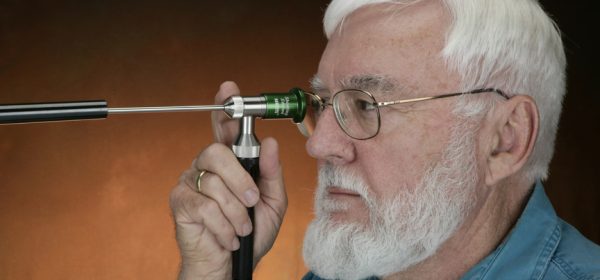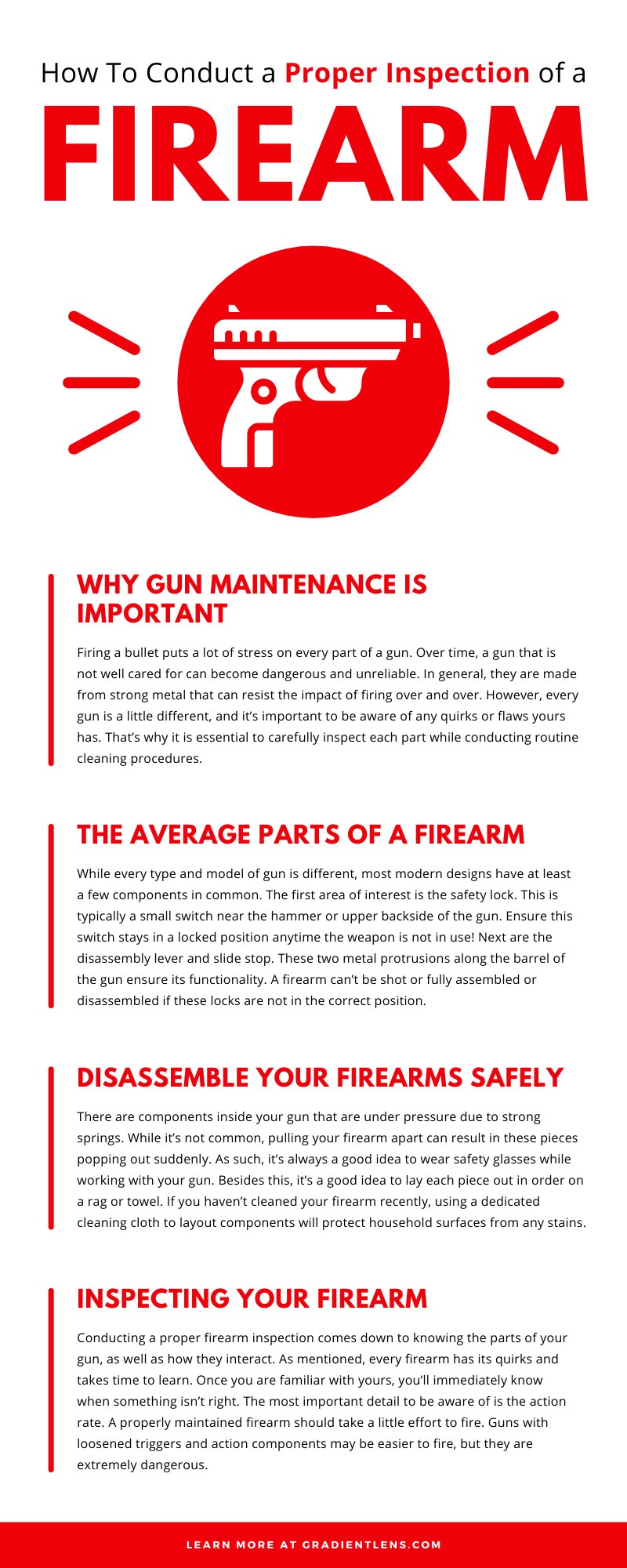How To Conduct a Proper Inspection of a Firearm

March 12, 2021
Owning a firearm is a lot of responsibility—not only to your safety and those around you, but also to the gun itself. Firearms are intricate mechanical puzzles with many moving parts. As such, they must be maintained and cared for to keep them functional and safe. Knowing how to conduct a proper inspection on a firearm is a must-have skill for every owner and enthusiast.
Why Gun Maintenance Is Important
Firing a bullet puts a lot of stress on every part of a gun. Over time, a gun that is not well cared for can become dangerous and unreliable. In general, they are made from strong metal that can resist the impact of firing over and over. However, every gun is a little different, and it’s important to be aware of any quirks or flaws yours has. That’s why it is essential to carefully inspect each part while conducting routine cleaning procedures. A gun should be cleaned at least every month, though it should ideally be lubricated weekly. Once you own a gun, take the time to become efficient at stripping it and reassembling it. Learn every part and look for any potential issues.
This is especially true if you frequently use it for plinking, target shooting, and hunting. The more you use your gun, the dirtier it gets. Residue from gun powder can gum up a gun’s workings and reduce the efficiency of parts. This means stiffer action and potentially even dangerous misfires. Firearms are complex mechanisms that need very specific care.
The Average Parts of a Firearm
While every type and model of gun is different, most modern designs have at least a few components in common. The first area of interest is the safety lock. This is typically a small switch near the hammer or upper backside of the gun. Ensure this switch stays in a locked position anytime the weapon is not in use! Next are the disassembly lever and slide stop. These two metal protrusions along the barrel of the gun ensure its functionality. A firearm can’t be shot or fully assembled or disassembled if these locks are not in the correct position.
Moving on we have the hammer and trigger. These two connected parts are responsible for a gun firing. There are many kinds of trigger mechanisms that include extra safety or convenience features. This boils down to how easily and quickly a gun can be shot. Home protection models, for instance, often have triggers that can be depressed about halfway before the extra effort is needed to fire. This is a useful safety feature, especially for new handgun owners and people that are not collectors or marksmen hobbyists.
The slide and barrel are the two upper-most sections of a firearm. Typically, only handguns feature a slide. This is a moving piece that allows an empty jacket to be ejected from the barrel to make room for a spring-action reload. In traditional designs such as with rifles and shotguns, there are no semi- or automatic features and must be broken and manually reloaded after each round. Revolver-type guns use a spinning cylinder rather than a horizontal slide. It’s a good idea to research the slide of your gun and to take the time to practice firing it. That way you can test for any problems such as jackets becoming stuck in the slide.
Finally, we have the grip and magazine. The grip is typically one hollow section into which all other parts nestle. The magazine snaps within the grip and lines up perfectly with the reload mechanism inside. Within the gun, there are typically taut springs and metal bracing that enable the powerful snapping back of the hammer. Study how these internal components are arranged in your firearm to better understand how it works, as well as how to efficiently reassemble it.
Disassemble Your Firearms Safely
As mentioned, there are components inside your gun that are under pressure due to strong springs. While it’s not common, pulling your firearm apart can result in these pieces popping out suddenly. As such, it’s always a good idea to wear safety glasses while working with your gun. Besides this, it’s a good idea to lay each piece out in order on a rag or towel. If you haven’t cleaned your firearm recently, using a dedicated cleaning cloth to layout components will protect household surfaces from any stains.
Remember to always point the gun away from you as you begin taking it apart. First, empty your gun of ammunition. This includes removing the magazine and checking the chamber for a loaded bullet. Set aside the magazine on the towel. Next, pull back the slide and push the stop to the open position. The slide will come away, revealing the barrel.
Carefully remove this part and make note of exactly how markers on the barrel line up with the frame along with the grip. Take out the now revealed internal components, once again paying special attention to how they fit together. Depending on your model and type, there may be more or fewer parts and safety features that need to be attended to before the slide and barrel will come away.
Inspecting Your Firearm
Conducting a proper firearm inspection comes down to knowing the parts of your gun, as well as how they interact. As mentioned, every firearm has its quirks and takes time to learn. Once you are familiar with yours, you’ll immediately know when something isn’t right. The most important detail to be aware of is the action rate. A properly maintained firearm should take a little effort to fire. Guns with loosened triggers and action components may be easier to fire, but they are extremely dangerous. Tampering or wear of this kind can result in a hair-trigger that fires due to accidental impact and jarring, such as while being transported to a range. They can also misfire and cause injuries.
Besides a gun’s action mechanism, always check for grime and other obstructions. This too can create a dangerous misfire, so carefully check over and clean every piece—including the barrel. Even with a fully disassembled firearm, you should never look directly into the barrel. Instead, utilize a rigid borescope inspection camera to check for cracks, flaws, or buildup of residue. This tool is used commonly by gun manufacturers and firearms professionals and is the safest approach to checking the barrel.
Cleaning a gun is very simple. Everything you need to flush the barrel and wipe down the parts should be included in a standard cleaning kit. Before assembling and storing, remember to lubricate the components.
